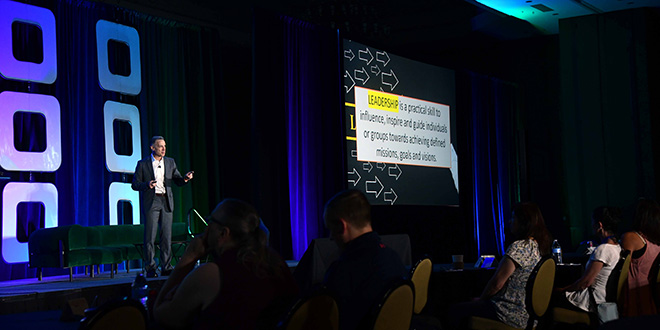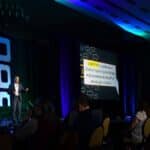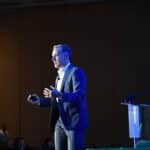
Apply the Amazon Way to Your Operation
As a business strategist and expert on digital transformation, leadership and business reinvention, John Rossman shared leadership skills for innovation during his keynote address at the 2023 NHPA Independents Conference.
As an innovative leader, it’s key to become customer-obsessed and work vigorously to build customer trust. Part of building that trust is reducing customer friction and looking at the entire customer experience beyond in-store purchasing, Rossman says.
“I think friction is one of the most important concepts to talk about when you’re talking about innovation,” Rossman says. “Your customers are at constant points of needing help, so tune into the moments of pain for your customers and become a hero.”
Rossman recommends using metrics to build a culture of accountability and customer obsession. When looking at metrics, go beyond the basics and choose those metrics that are most applicable. He says it’s also crucial to not just take into account the averages, but look at the low and highs, so you can build on what’s working and change where there are problems.
“Make metrics a verb to relentlessly chase perfection,” Rossman says.
Innovators need to be willing to be misunderstood when changing the industry norms or traditions that will benefit the customer.
“If you do something that isn’t like what everyone else is doing, be prepared to be criticized,” Rossman says. “Be willing to bend the curve, especially when it comes to benefitting the customer.”
Other takeaways on being an innovative leader included:
- Start by thinking in outcomes. “The first part of innovation is envisioning something that doesn’t exist today. If you can describe in detail what your outcome is, you can better see potential obstacles and overcome them before you even start.”
- Have a process in place to test ideas. “You need to have an actual agile process in order to test something. Small and medium-size businesses are at an advantage because you are actually agile and have that ability to be flexible.”
- Principles are not a poster. “Don’t just talk about leadership and innovation, but build the mechanisms to put those principles to work.”
More Insights From John
Read an exclusive conversation with John and listen to a podcast below.
North American Hardware and Paint Association (NHPA): What are some of the highlights of your career and the biggest takeaways you’ve come away with?
John Rossman (JR): Like any career, it has had some highlights and lowlights along the way. Some of the highlights for me include being a partner at Arthur Andersen early in my career and joining Amazon in 2002. I led the launch of the Marketplace business at Amazon, which today comprises well over 50% of all units shipped and sold. I also led another business at Amazon called Enterprise Services that didn’t work so well; I’ve found that typically you learn more from the things that didn’t go great than you do from the things that did go great. After I left Amazon in late 2005, I was a partner for 12 years at a management consulting firm, Alvarez and Marsal, where I had some of the best clients in the world, including the Bill and Melinda Gates Foundation. I was also an interim CIO for a retail client, and along the way, I wrote a book called “The Amazon Way” and in 2017, I founded Rossman Partners. Whether it’s through my books, keynotes or my advisory business, for me, the end goal is helping leaders evolve their strategy and leadership principles for today’s competitive needs. People talk about digital transformation and disruption, but the key is taking care of business. It’s about competing with new business models, new approaches and new expectations. I love to walk leadership teams through not necessarily rethinking everything, but adding additional capabilities to their already great businesses to enhance and future-proof it for what customers in the market expect today.
NHPA: Tell us how your experiences with Amazon helped to shape the consultant and speaker you are today.
JR: When I joined Amazon in March 2002, the company had just had its first billion dollar quarter, but it was still unclear whether we were going to succeed. During that time, the leadership principles weren’t codified but we were practicing them every day. We were really hammering out and asking questions like “What do we prioritize?” and “How do we make decisions and hold each other accountable?” and “What is our culture defined as?” It was a really interesting time at Amazon because it became clear that we were not just a retailer, we were a platform company that built capabilities others use. The way Amazon goes about getting its work done, how it thinks about leadership and how it tries to hold everyone in the organization accountable, those things are exactly the same, both philosophically and from a practical standpoint. That’s part of the lesson—these operation goals scale and they’re durable, and I’ve had a ton of experience in taking some of these aspects and putting them into other businesses for the right effect. That’s been the playbook that I’ve used in my client work over the past 20 years, and I’ve seen the impact and the power. But it really does start with leadership and the willingness to add some new perspectives and try some new methods in order to get different results.
NHPA: Give us a sneak peek into what you’ll be sharing with attendees of the 2023 NHPA Independents Conference in August.
JR: We’re going to take a quick dance across some of the Amazon leadership principles and give examples both from Amazon and around the industry. I’m going to give a little bit of a playbook on some things companies can do. What most companies and most leaders are really good at is their operating playbook, but what I’m going to share about is a little bit of an innovation playbook to complement that operating playbook. Some of the things you do in your operating playbook sound like some of the things you do in your innovation playbook, but they actually have a distinctively different orientation and prioritization. For example, in your operating playbook, you’re typically trying to prioritize or optimize for aspects like customer satisfaction and unit economics. But when you’re innovating, you’re trying to optimize for deep learning about a new customer need or satisfaction. People don’t understand that the scientific process starts from failure, and you earn your way up to success. Most of us have this expectation that we’re going to start from success and then just refine it but you have to be ready to have repeated failure.
Key Takeaways
- Become customer-obsessed and innovate to reduce customer friction.
- Work backwards with any ideas to seek clarity before building.
- Build mechanisms to put principles to work.
Leadership is a skill. It's the ability to influence and inspire others to accomplish a specific mission. As a leader, you have to make room for innovation in your schedule, in your agenda.
- John Rossman
Business Strategist
- Follow John on LinkedIn




